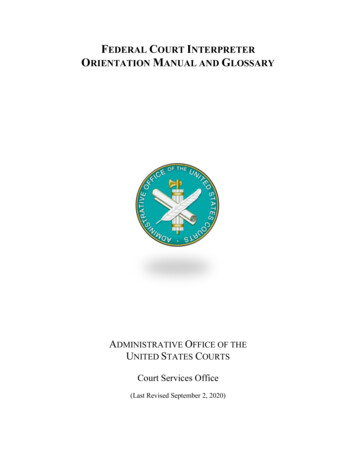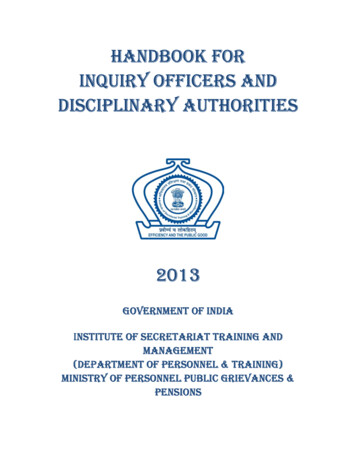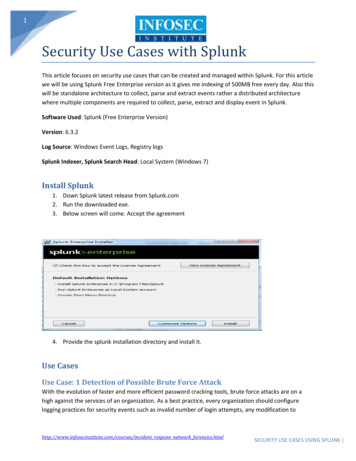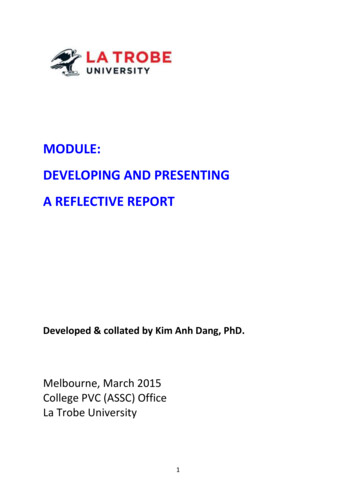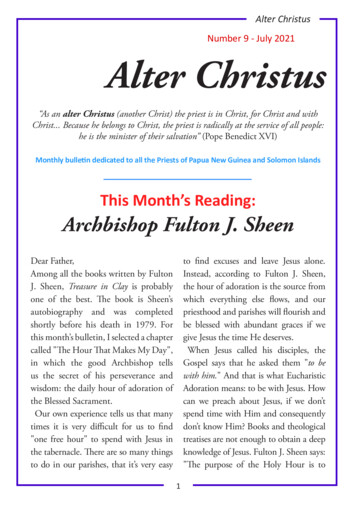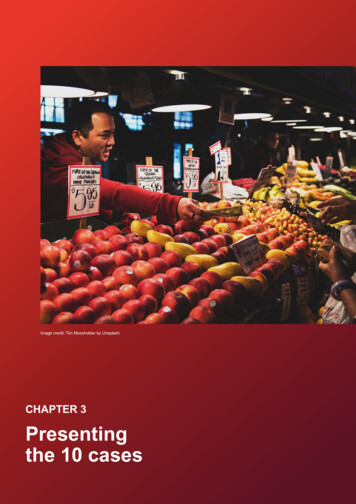
Transcription
Image credit: Tim Mossholder by UnsplashCHAPTER 3Presentingthe 10 casesNational and Sub-National Food Systems Multi-Stakeholder Mechanisms 69
2. Presenting the seven casesselected at sub-national levelImage credit: Szefei by ShutterstockAt sub-national level in Europe and North America,many MSMs are linked to the development andimplementation of a holistic sustainable food systemspolicy. These groups are generally known as foodpolicy councils (FPCs), but they also go by othernames.In contrast, such MSMs are difficult to find in the GlobalSouth. There are some cities leading the way in LatinAmerica, but they are still at an early stage. Examplesinclude La Paz, Quito, Lima and Medellín.Some SFS MSMs are currently being formed in Asiaand Oceania, and some of them are already engagedin the assessment of food systems and the definition ofpriority topics and actions. Examples include Surabayaand Melbourne.In the case of African cities and towns, several SFSMSMs are promoted and supported by variousinternational organizations and cooperation projects(with technical and financial support from organizationssuch as FAO, Rikolto, Hivos, Biovision, RUAF, theAlliance of Bioversity International and CIAT). Levels oflocal ownership, government involvement and concreteachievements vary, depending on the mechanism.The following section presents a summary of theseven SFS MSMs selected at sub-national level:London, Ghent, Los Angeles, Montreal, Quito, La Pazand Antananarivo. The most relevant features arecompiled from a literature review and the resultsfrom both surveys.National and Sub-National Food Systems Multi-Stakeholder Mechanisms 98
2.2. London (UK): London Food Board (LFB)Image credit: GLA/Caroline Teo2.2.1. About the London Food BoardThe London Food Board (LFB) was created in 2004.It was championed and established by the first Mayorof London, Ken Livingston, who convened severalindependent food-related organizations and expertsfrom all over London with the primary objective ofadvising the mayor and the Greater London Authority(GLA) Food Team on the food issues affectingLondoners. These organizations and experts werealso requested to participate in policy formulationprocesses by sharing their knowledge and expertiseto help shape the London Food Strategy. The LFB is aformally institutionalized SFS MSM hosted by the GLA,which also occupies the leadership role. The processleading to its set-up took less than one year.The LFB’s objectives are focused on three mainthemes: Implementation of the London Food Strategy; itywide food issues and the development of aCbetter food system for all Londoners; The London Food Programme.To date, the LFB has prioritized and addressed issuesrelated to (but not limited to) food security and poverty,local food production, (peri-)urban agriculture, nutritionand health.Its geographical scope of action is the city level, butit also has established connections with networks atthe international, national, sub-national and boroughlevel for policy implementation. For instance, the LFBconnects with London local authorities, the SustainableFood Places network and the C40 Cities Food SystemsNetwork, among others. It takes the London FoodStrategy as the main framework to guide its work.The LFB relies on a minimal budget from the GLA.This budget is used to cover the costs of meetinglogistics, activities to foster learning exchange, andalso to launch new projects.2.2.2. Structure and governanceStructureThe London Food Board comprises 18 memberswho advise the Mayor of London and the GLA. Theparticipating stakeholders are selected followinga recruitment process (including interviews). Theyare then appointed by the mayor, based uponrecommendations by the GLA food team and relevantmembers of the Mayor’s Office. A small number of coopted organizations from key sectors are representedon the LFB.National and Sub-National Food Systems Multi-Stakeholder Mechanisms 107
Figures 51, 52 and 53 illustrate the representativenessand inclusiveness of the LFB, showing the diversityof participating stakeholders in terms of types oforganizations (constituencies), sectors and foodsystems activities represented.GovernanceThe LFB has a written document that describes itsstrategic direction and governance principles, whichhave been agreed upon by all parties and are depictedin Figure mers'organizationLondon FoodBoardPublicauthorityPrivatesectorCivil societyNGOFigure 51. Types of organizations (constituencies) represented on the London Food Board (in ndon nceFigure 52. Sectors represented on the London Food Board (in red)National and Sub-National Food Systems Multi-Stakeholder Mechanisms 108
ProducefoodPolicy work onsustainable foodsystemsEducation/communicationto citizens aboutsustainable foodSell andmarket foodLondon FoodBoardProvide training onsustainable foodsystems topicsProvide services,information, dataor toolsResearch onfood systemsAdvocate forsustainablefood systemsAdvise/consulton food systemsFigure 53. Activities represented on the London Food Board (in red)Sound financialmanagementInclusivenessand equityEngagementTrust,networking andrelationshipsRespect forhuman rightsand diversityLondon FoodBoardInnovation &openness tochangeRule of law andethical eadership(collaborative sFigure 54. Good governance principles practised by the London Food Board (in red)National and Sub-National Food Systems Multi-Stakeholder Mechanisms 109
The LFB has internal procedures to put these principlesinto practice, such as established mechanisms formanaging conflicts of interest, capturing and taking intoaccount all voices, ensuring effective communication,building consensus, learning collaboratively, andbuilding capacity.The SFS MSM usually holds quarterly scheduledmeetings, and 60 per cent of the stakeholders surveyedindicated that they attend all meetings; 40 per centdedicate more than 4 hours a month to the work ofthe SFS MSM, while the other 60 per cent dedicate1 to 4 hours. In 60 per cent of the cases, members’participation is sponsored by the organizations theyrepresent. The latter is usually in charge of settingthe agenda, prioritizing urgent issues. Prior to eachsession, the purpose, topics and questions to beaddressed are clearly defined so that stakeholders areinformed prior to the meeting. A designated facilitatorensures a constructive and inclusive dialogue, andnote-takers and rapporteurs are designated to takethe minutes. The LFB has a mechanism to workcollaboratively and include comments in the minutes.The LFB also fosters participation through theBoroughs Food Group;89 all London boroughs areinvited to participate in this group. It meets quarterly(during the COVID-19 pandemic, it met fortnightlyor monthly) and involves key partners representingLondon local authorities, national agencies and thirdsector organizations. LFB officers provide secretariatsupport to help local authorities and external partnersshare best practices. They support discussions onworking together to address the issues facing London’sfood system, from childhood obesity and food wasteto improving access to healthy and sustainable food,especially for disadvantaged communities. In additionto regular meetings and engagement with the BoroughsFood Group, participants also communicate periodicallythrough emails, calls and other means.2.2.3. Policy formulation and implementationSFS policy formulationThe LFB conducted a joint assessment of the city’sfood system using a systemic approach, whichprovided a detailed understanding of existingchallenges. This diagnosis included mappings of foodsystems actors and food-related policies. It providedan overview of the potential levers for greater collectiveaction and policy development.In 2006, the GLA food team developed the LondonFood Strategy90 in collaboration with the LFB onbehalf of the mayor of London; a second LondonFood Strategy was developed in 2018. The 2006strategy was formulated following a consultationprocess that gathered feedback from the generalpublic and organizations on the draft document. Thisstrategy proposed an overall vision for London’s “foodinfrastructure” up to 2016. It had five main objectives,including actions to improve the health of Londonersthrough a better diet, and focused on increasing thechoice, availability and quality of food for all, especiallythe most disadvantaged populations.Similarly, the 2018 London Food Strategy had a verythorough consultation process during which a draftversion of the strategy was published over an eightweek period; almost 150 organizations and thousandsof members of the public provided feedback. This openconsultation also comprised surveys, focus groupsand the GLA Talk London platform.91 The final versionof the London Food Strategy took into account allthe responses and was successfully integrated intothe mayor’s range of strategies.92 The priorities andcommitments of the strategy are mutually reinforcing.In addition to the open consultation, the 2018 LondonFood Strategy took into consideration a preliminarydiagnosis of the food system as well as input frominternational cooperation. The policy documentproposes a series of actions to improve food in a widerange of areas, including maternity and early years,education, business, community and leisure, publicenvironments, public institutions, community gardensand urban agriculture, at work, at home, and eating out.It also seeks to ensure that policies and commitmentsto action are integrated at all levels.The London Food Strategy focuses on promoting “goodfood”, defined in the policy document as healthy andnutritious food for all cultures and needs; food that isfair, inclusive and sustainable; skilled and profitable;planet-friendly and humane, sustainably produced;safe and celebrated (GLA, 2018). The policy aims totackle three major food-related problems in London:child obesity, Londoners’ reliance on food banks andglobal greenhouse gas emissions from food production,A subgroup of the London Food Board consisting of over 200 members with representatives covering a range of disciplines including public health, economicdevelopment, education and environmental health. Each meeting is attended by an average of 50 representatives from approximately 20 different municipalities andother key external pdf91https://www.london.gov.uk/talk-london/92These strategies include the draft New London Plan, the London Health Inequalities Strategy, the mayor’s Economic Development Strategy, the LondonEnvironment Strategy, the mayor’s Transport Strategy, the Culture for All Londoners Strategy, the mayor’s Skills for Londoners Strategy, the mayor’s Vision for aDiverse and Inclusive City, a Tourism Vision for London, and a Vision for London as a 24-Hour City.89National and Sub-National Food Systems Multi-Stakeholder Mechanisms 110
contributing to London’s poor air quality. It definesconcrete actions for each food environment in whichLondoners get their food. ood food at home and reducing foodGinsecurity: Promoting the London Living Wage,93ensuring that children from low-income familieshave access to healthy food during school holidaysand developing long-term solutions to householdfood insecurity. ood food economy, shopping and eatingGout: Promoting the role that food can play inmaking streets healthy places, with more healthyfood options and good food businesses. There isa particular focus on advertising restrictions onfoods and non-alcoholic drinks that are high in fat,sugar and salt, and the development of a range ofschemes to promote values-driven food businessesand social enterprises. ood food in community settings and publicGinstitutions: Through better food procurement,small businesses and local producers can helppeople eat healthier food with better animal welfareand environmental standards. ood food for pregnancy and childhood:GCitywide action to reduce child obesity and relatedinequalities, for instance by reducing children’sexposure to junk food including by restrictingadvertising. This topic also includes improvingLondon children’s health and supporting healthierhabits through the Healthy Schools London andHealthy Early Years London programmes; the latterincludes actions to promote breastfeeding. ood food growing, community gardensGand urban farming: Supporting food growing incommunity gardens, allotments, schools, urbanfarms and other spaces in London. This has manyenvironmental benefits. This includes addingto London’s green infrastructure and providinghabitat for London’s biodiversity. Urban farmingand food growing projects also help to createsocial enterprises that boost local economies andprovide jobs, volunteering opportunities, training andapprenticeships. ood food for the environment: This includesGactions on the production, distribution, transportand consumption sides. It also includes actions toaddress food waste.In addition to the London Food Strategy, the LFB hasalso provided input to other statutory and non-statutoryCity Hall strategies, such as the London EnvironmentStrategy, the London Spatial Development Strategy,(commonly as known the London Plan) and others.Image credit: GLA/Caroline TeoThe London Living Wage is an hourly rate calculated according to the basic cost of living by the Living Wage Foundation (currently GBP 10.20 (EUR 11.99) perhour). As accredited Living Wage employers, councils can help to ensure that staff employed and contracted by the local authority do not experience in-work poverty.93National and Sub-National Food Systems Multi-Stakeholder Mechanisms 111
SFS policy implementationThe implementation of the London Food Strategyis led by the GLA food team on behalf of the mayor.His Implementation Plan94 sets out the actions to betaken and supported between 2018 and 2023 to helpachieve the strategy’s objectives. The plan includestimelines and a series of indicators that will be used tomeasure and report on progress across London. TheLFB has a communications role and provides adviceon the strategy’s implementation efforts. Sustain95 andthe London Food Link network96 are the London FoodBoard members overseeing the implementation of theLondon Food Strategy.The LFB also advises the GLA on the implementationof the London Food Programme. A small team of GLAofficers lead the delivery of this programme, which sitswithin the Communities and Social Policy Unit. Theprogramme works with private, public and third sectorpartners, developing and delivering projects that usegood food to improve the quality of life of Londoners.The implementation of the London Food Strategy issupported through the London Food Programme,and colleagues from the GLA health, planning,environment97 and volunteering teams workclosely together. This ensures that the programmecomplements the work being done across the city.The LFB and GLA is a member, and Silver Awardwinner, of the Sustainable Food Places network(previously the Sustainable Food Cities Network),98which connects the work of food partnershipsacross the UK to address the social, economic andenvironmental challenges of their food systems.of respondents). In addition, respondents mentionedthe successful mainstreaming of the topic of food intobroader policy-making processes.The LFB can be credited with putting in placepioneering strategies focused on reducing childhoodobesity.99 These actions have targeted reducingchildren’s exposure to junk food by restrictingadvertising and assisting boroughs in developing plansto promote the marketing of high-quality and nutritiousfood. In addition, proposals have been put forwardto restrict the opening of new take-away food outletswithin 400 metres of schools. In addition, the HealthierCatering Commitment100 aims to help food outlets makesimple changes to sell healthier food.Some of the stakeholders surveyed indicated thatby working with the LFB, they have benefited fromnetworking, learning and access to innovative ideasand partnerships. They have also recognized theimportance of the role markets play in the food supplychain. In addition, they appreciate having a platformto engage and collaborate with locally, and havingthe opportunity to influence the GLA’s thinking andcollective voice.Since 2011, the London Food Link, supported by theLondon Food Programme and the LFB, has publishedthe annual Good Food for London report.101 This reportoutlines important achievements. Some of the mainones are listed below. 2.2.4. Reported achievementsand challengesAchievementsAccording to the stakeholder survey, the LFB’smain achievement has been its contribution to theformulation of policies, in particular the London FoodStrategy, and the contribution it has made to thepromotion of these policies (indicated by 80 per cent ore local councils are committed to the LocalMGovernment Declaration on Sugar Reductionand Healthier Food102 and the SUGAR SMART103complementary campaign, focused on tacklingexcessive sugar consumption through actionsacross 10 sectors. These range from reducingsugary drinks for sale in restaurants and retail toorganizing public awareness campaigns. In 2018,10 councils signed the Local GovernmentDeclaration and 12 are running SUGAR SMARTcampaigns. Additionally, 7 councils are in theprocess of signing and/or setting up a iles/implementation plan 2018-2023.pdfSustain is a powerful alliance of organizations and communities working together for a better system of food, farming and fishing, and cultivating the movement forchange. https://www.sustainweb.org/about/96London Food Link was created in 2002 as an umbrella for all Sustain initiatives in London, seeking to influence local government policy, providing practical trainingon food growing, organizing sessions for public sector suppliers, creating guidance for independent restaurants and food producers, running public awarenesscampaigns, and joining the dots between people around specific food issues. London Food Link’s network of partners is open to all who grow, produce, teach, sell,promote and simply enjoy good food in London. he aim of the Local Government Declaration on Sugar Reduction and Healthier Food is to achieve a council-led commitment to improve the availability ofhealthier food and to reduce the availability and promotion of unhealthy food, particularly foods and drinks that are high in sugar. et artuk.org/9495National and Sub-National Food Systems Multi-Stakeholder Mechanisms 112
apital Growth104 is London’s largest food growingCnetwork. A total of 31 councils are actively involved,and the network has supported over 2,900 growingspaces across all 33 boroughs since it waslaunched in 2008. The Capital Growth network hasengaged over 150,000 volunteers in growing foodand recorded a harvest of over a million portions offruit and vegetables with an estimated value of GBP600,000 (EUR 705,543).105 ore councils are London Living Wage FriendlyMFunders, and six boroughs have received top marksfor being accredited London Living Wage employersor Friendly Funders and for promoting the schemelocally. I n catering, many boroughs are committed to highfood standards. Two-thirds have achieved at leastBronze Food for Life Served Here106 accreditationin the majority of their schools and/or other cateringunder council control (care homes, workplacecanteens or early years settings). hildren’s health and school food culture remainCa strong focal point for action as well, with 31boroughs having at least some schools engagedwith Healthy Schools London and/or the SoilAssociation’s Food for Life Awards. ight boroughs have active local food partnershipsEthat are members of the Sustainable Food Placesnetwork. ourteen boroughs have Fairtrade status, andFsix are overdue in renewing their status or in theprocess of achieving this status.ChallengesThe main challenge identified by all survey participantsis the lack of mandatory regulation for the stakeholdersengaging in the SFS MSM. Moreover, 60 per centof stakeholders considered the lack of budget tosupport participation and collaboration as anotherimportant obstacle. Finally, 60 per cent of respondentsindicated that the leadership’s strategies for resolvingdisagreements between parties could be improved,showing that there is an opportunity to enhance themanagement of constructive dialogue, power relationsand trade-offs.2.2.5. Conclusion: Drivers of successfor the London Food BoardLondon is a recognized leader in international foodnetworks. It is a key partner in the C40 Cities FoodSystem Network and the MUFPP. The contributionsmade by the GLA and the LFB have been soremarkable that they earned them a Silver Award fromthe Sustainable Food Cities Network (as it was) in2017. Working through the Mayor’s Office, the GLAfood team and the LFB have formulated strategies andconvened working groups to address the problems inLondon’s food system, with particular attention paid toreducing childhood obesity and inequality. The city hascommitted to halving the percentage of primary schoolchildren who are overweight or obese by 2030, and toreducing the gap in childhood obesity rates betweenthe richest and poorest areas of London. Together,community representatives, businesses, institutionsand the government have focused on good foodstrategies to improve people’s lives in different areas. Intrying to alleviate diet-related diseases, they have alsobuilt stronger communities.According to the study, the success and achievementsof the London Food Board are attributableto a combination of factors, ranging from itsrepresentativeness and the commitment of its membersto having key partnerships with initiatives such as theC40 Cities Food System Network and the MUFPP.All the survey participants agree that the stakeholdercomposition of the LFB adequately reflects the diversityof sectors present in the London food system, and thatthe balanced representation of all stakeholders is oneof the strongest drivers of collaboration.The SFS MSM also owes its success to theengagement of its members which, according to 80per cent of respondents, is medium to very high.Broken down by constituency, all participatingstakeholders feel that the public sector is the mostengaged, followed by civil society (according to 80 percent of respondents), the private sector (according to60 per cent) and farmers (according to 20 per cent).Some of the main reasons that motivate membersto be part of the mechanism’s work include advocacyand learning purposes (reported by all the respondents)and networking (reported by 80 per cent).104Capital Growth helps community gardens, schools, allotments and home growers to gain skills and grow food in the city through training, advice and networkingopportunities.105All currency conversions were carried out on 22 July 2021.106The Soil Association’s Food for Life Served Here award is an independently awarded accreditation for caterers. The award helps organizations ensure that theyare recognized for serving more local, fresh and honest food. To achieve the Bronze standard, caterers must demonstrate that they are cooking from scratch usingfresh ingredients that are free from trans fats and better for animal welfare. The Silver and Gold awards recognize caterers for practices such as making healthyeating easier, championing local producers and sourcing environmentally friendly and ethically produced ingredients.National and Sub-National Food Systems Multi-Stakeholder Mechanisms 113
Government buy-in has been pivotal to the LFB.About 80 per cent of respondents consider the levelof government buy-in to be medium to very high,including the support of high-level representatives forthe mechanism.Good governance within the LFB has certainly been akey part of its success. All the stakeholders surveyedbelieve that the LFB respects the code of conductand principles of good governance agreed upon byall parties, and that its meetings are well organized,communication is transparent, clear and effective, andits structure and processes are conducive to equitablerepresentation and participation of all its members.Furthermore, 80 per cent of respondents concur thatthe majority of formal members actively participate inthe work of the SFS MSM and that the participatorylearning processes in place are conducive to thecapacity building of its members.Another factor that has contributed to the LFB’sperformance is the good quality of its leadership. Allthe respondents indicated that the products generatedby the SFS MSM adequately reflect its members’contributions. They believe that the leadership sharespower in decision-making, is receptive to new ideas,encourages all members to participate, and activelywelcomes new members. In addition, the vast majorityof respondents (80 per cent) think that the leadershipuses good strategies to manage conflicts of interestand power relations, and that it provides opportunitiesfor members to build leadership skills within the board.A clear, well-defined strategic vision and anunderstanding of key policy-related issues have beenfactors in the success of the LFB. In this regard, allthe stakeholders surveyed indicated that the LFBunderstands the general policy environment relatedto its priorities and has clearly articulated its vision,mission and goals among its members. Some 80 percent also indicated that the food systems approach topolicy formulation and implementation is understood bymost of the stakeholders that make up the SFS MSM.Another key element pointed out by respondentsis the LFB’s effectiveness in meeting the healthand nutrition needs of the most vulnerable and itscapacity to support effective decisions in the contextof COVID-19. At the beginning of the pandemic, anadditional LFB subgroup – the Food Aid Sub-Group –was established to monitor and escalate issues andrisks associated with COVID-19-related food insecurityand food aid. This subgroup has been an essentialpart of London’s response to the pandemic. Likewise,80 per cent of respondents believe that the LFB haseffectively included the food systems approach andthe environmental sustainability component in its work,while the same percentage believe that the strategiesto promote collaborative and coordinated actionamong all food system stakeholders are constructive.Meanwhile, 60 per cent of respondents think that themechanism has fostered an inclusive and constructivedialogue among all food system stakeholders.Looking to the future, 80 per cent of respondentsbelieve that the issues to be prioritized by theLFB should be sustainable food production, urbanagriculture and short supply chains, local markets,and food loss and waste.Image credit: Tom Grünbauer by UnsplashNational and Sub-National Food Systems Multi-Stakeholder Mechanisms 114
insecurity: Promoting the London Living Wage,93 ensuring that children from low-income families have access to healthy food during school holidays and developing long-term solutions to household food insecurity. Good food economy, shopping and eating out: Promoting the role that food can play in making streets he


